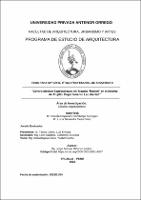| dc.contributor.advisor | Miñano Landers, Jorge Antonio | |
| dc.contributor.author | Arimborgo Sisniegas, Claudia Emperatriz | |
| dc.contributor.author | Cieza Pérez, Lucía Alexandra | |
| dc.creator | Arimborgo Sisniegas, Claudia Emperatriz | |
| dc.date.accessioned | 2023-02-22T17:27:36Z | |
| dc.date.available | 2023-02-22T17:27:36Z | |
| dc.date.issued | 2023 | |
| dc.identifier.uri | https://hdl.handle.net/20.500.12759/10351 | |
| dc.description.abstract | El presente trabajo de investigación se desarrolla en el marco de la problemática
trujillana ante la cobertura de la demanda del servicio de emergencias en los
hospitales pertenecientes al MINSA, en la región macro norte, siendo estos el
Hospital Regional Docente De Trujillo (HRDT) y el Hospital Belén De Trujillo (HBT).
Ambos establecimientos cuentan con una antigüedad de más de cincuenta años y
a pesar de contar con remodelaciones realizadas a lo largo del tiempo, la calidad
del servicio de emergencias no es la adecuada para la demanda de la población
actual de Trujillo.
En el caso del HBT, la unidad de emergencia no cuenta con un diseño adecuado
para brindar un servicio óptimo a los usuarios, poniendo énfasis en la atención del
paciente de prioridad I, el cual requiere ser estabilizado lo más pronto posible. A
pesar de que la unidad de emergencia tiene como objetivo brindar una atención
oportuna, existen varios factores que alargan el tiempo de espera de atención de
los usuarios, esto sumado a la alta demanda del servicio de emergencia en la región
macro norte, deriva en una atención colapsada. La presencia de camillas
improvisadas en los pasillos del área de emergencias evidencia las condiciones en
las que se encuentra la unidad, situación que se vería empeorada en algún caso
de emergencia sanitaria debido a que, la infraestructura de los ambientes de
emergencia, no están diseñados para responder al aumento de demanda del
servicio de salud.
La evaluación de la problemática actual deriva en objetivos propuestos para el
proyecto que se buscan alcanzar con el planteamiento de un programa
arquitectónico, estos están íntimamente relacionados con las bases teóricas
estudiadas brindando así, estrategias que apoyan al diseño del centro médico. Se
consideran puntos que engloban la funcionalidad, el bienestar del usuario y la
naturaleza reflejada en el diseño biofílico, todo ello se define en el concepto
planteado por el proyecto: “Acceso secuencial | es_PE |
| dc.description.abstract | The present research project is carried out in the framework of the Trujillian
problematic in view of the demand coverage for the emergency services in the
hospitals belonging to the MINSA, in the macro north region, being these: Regional
Teacher Hospital of Trujillo (HRDT) and the Belén Hospital of Trujillo (HBT). Both
establishments are over fifty years old and despite having remodeling projects
carried out over time, the quality of the emergency service is not appropriate for the
demand of the actual population of Trujillo.
In the case of the HBT, its emergency unit doesn’t have a suitable design to provide
optimal healthcare to users, emphasizing on the attention of “Priority I Patients” who
require to be stabilized as soon as possible. Even though the emergency unit aims
to provide immediate attention, there are various factors which extend the waiting
time for patient care, which, in addition to the emergency services high demand in
the macro north region, derives in a collapsed emergency unit. The presence of
improvised stretchers in the hallways of the emergency area shows the actual
conditions of the emergency unit, this situation could be worsened in the case of a
state of health emergency, due to the fact that the infrastructure of the emergency
unit is not designed to respond to the increased demand of health services.
The evaluation of the current problem situation results in the proposed objectives
for the project, which are meant to be reached with the development of an
architectural program, these objectives are highly related with the theoretical bases
studied, delivering strategies which support the design of the medical center. Points
that encapsule the functionality, the user well-being and nature reflected in the
biophilic design, are considered, all this is defined in the concept advanced by the
project “Sequential Access | en_US |
| dc.description.uri | Tesis | es_PE |
| dc.format | application/pdf | es_PE |
| dc.language.iso | spa | es_PE |
| dc.publisher | Universidad Privada Antenor Orrego | es_PE |
| dc.relation.ispartofseries | MEM_ARQ_735 | |
| dc.rights | info:eu-repo/semantics/openAccess | es_PE |
| dc.rights.uri | https://creativecommons.org/licenses/by/4.0/ | es_PE |
| dc.source | Universidad Privada Antenor Orrego | es_PE |
| dc.source | Repositorio Institucional - UPAO | es_PE |
| dc.subject | Centro de Trauma | es_PE |
| dc.subject | Diseño Biofílico | es_PE |
| dc.title | Centro médico especializado en trauma ‘Maeich’ en el distrito de Trujillo, departamento la Libertad | es_PE |
| dc.type | info:eu-repo/semantics/bachelorThesis | es_PE |
| thesis.degree.level | Título Profesional | es_PE |
| thesis.degree.grantor | Universidad Privada Antenor Orrego. Facultad de Arquitectura, Urbanismo y Artes | es_PE |
| thesis.degree.name | Arquitecto | es_PE |
| thesis.degree.discipline | Arquitectura | es_PE |
| dc.subject.ocde | https://purl.org/pe-repo/ocde/ford#6.04.08 | es_PE |
| renati.advisor.orcid | https://orcid.org/0000-0002-9931-8507 | es_PE |
| renati.author.dni | 70001066 | |
| renati.author.dni | 73666614 | |
| renati.advisor.dni | 18135096 | |
| renati.type | https://purl.org/pe-repo/renati/type#tesis | es_PE |
| renati.level | https://purl.org/pe-repo/renati/level#tituloProfesional | es_PE |
| renati.discipline | 731176 | es_PE |
| renati.juror | Tarma Carlos, Luis Enrique | |
| renati.juror | León Saldaña, Catherine Azucena | |
| renati.juror | Kobashigawa Zaha, Ysabel Sachie | |
| dc.publisher.country | PE | es_PE |


